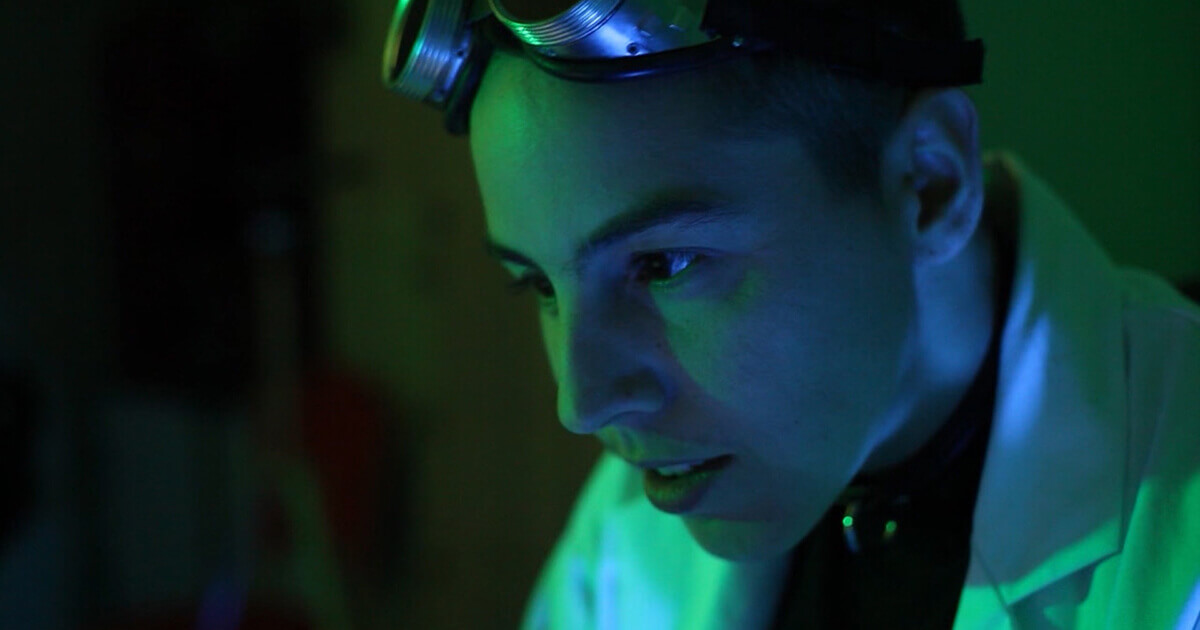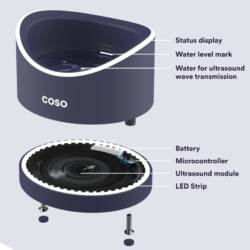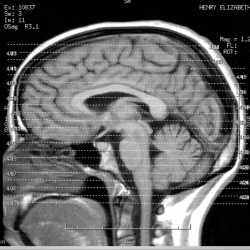Neurosex: Sci-Fi Series Translates Sex Into Code Your Brain Can Download
Project explores biotech fantasies in post-pornographic genre.
In an increasingly technological and sexualized world, how will our erotic lives play out in the future? What can we do now that may influence how different sexualities can be expressed and experienced?
A queer filmmaker named Eric has co-created the series Neurosex Pornoia as a way of examining such possibilities. We spoke to him about his creative undertaking and how likely his intriguing portrayal of “neurosex” is of becoming a reality.
[WARNING: Some images is the video below may be considered NSFW]
In a nutshell, what is your project Neurosex Pornoia?
It is a queer post-pornographic science-fiction film series and a space for exchange and experimentation.
I started it with Abigail Gnash in 2013 after we both became exposed to the works of Shu Lea Cheang and of a group of post-porn artists/activists in Spain like Quimera Rosa, Post-Op, Diana Pornoterrorista, and others via the Berlin Pornfilmfestival and the Entzaubert diy non-commercial queer film festival. We began to look for more material to watch, talk, and discuss about: cyberpunk, queer sci-fi, experimental and historical material, etc. In that process we started developing our own story.
What do you mean when you say “post-pornography”?
To me, post-pornography means being able to engage in explicit representations of sex without the primary goal of being arousing. Post-pornography comes from a queer feminist positioning that is aware of the political dimensions of sex imagery and narratives, like racist and colonialist genealogies, the oppressive use of notions like “public health” or “natural order” coming from a moralizing scientific and medical discourse, or the exclusion from the realm of desirability and sexuality of people with disabilities.
I like how Paul Preciado defines it:
“Postporno is not an aesthetic, but the assemblage of experimental productions that emerge from movements for the politico-visual empowerment of sexual minorities: pariahs of the pharmacopornographic system (bodies that work in the sex industry, prostitutes and porn actors and actresses, women dissenting against the heterosexual system, transgender bodies, lesbians, bodies with functional or psychic diversity) reclaiming the use of audiovisual devices for the production of sexuality.”
What exactly is “neurosex” in your story?
In the scenario of the Neurosex films, all humans have a brain implant, which is inserted with a minimally invasive surgery right after birth. This is a routine procedure, like cutting the umbilical cord.
This implant becomes part of the brain, it grows organically with it, developing terminals that are in touch with every single neuron. The implant and the terminals have two functions. First, they can record and store all the activity going on in the brain, all the signaling, all the connections. Second, they can intervene in its functioning. They can activate neurological pathways, block synapses, redirect or send signals, regulate the biochemistry of the synapses, block or activate entire brain regions, etc.
The implant and terminals communicate with an external device that, connected to a computer, can download and monitor the activity of a brain but also influence and regulate it via neurocodes. Neurocodes are neurological information that is sent to the implant and can be decoded and processed by the brain. This is not a utopian or dystopian technology, it is an ambivalent one, with many potential benefits and dangers.

Neurosex refers to the use of this technology for sexual pleasure. This becomes really interesting because neurosex challenges many notions of how we understand sex as a human/animal activity.
In western culture, which is the context of my experiences, sex is very visual and physical. Sex is something that bodies actively do, and it is something that is represented visually. In its mainstream version sex is usually penetrative straight or increasingly also gay male sex. The codes of the visual representations of sex are being challenged in feminist and queer porn and this is really amazing and necessary.
But we want to question the visuality and materiality of sex. Neurosex happens in the brain, as internal physiological process that does not have to have a correspondence to anything material happening. It is pure processing of signals generating neurological experiences that are sexually pleasurable. How do you represent that in a film? And what does pleasurable mean?
It makes us explore sex in a very different way. Sure, you could generate neurologically the best orgasm ever, but would that be so interesting, given the expanded possibilities that neurosex could offer? In episodes 1 and 2 we developed the base for a representation of neurosex, but it will be in Neurosex3 we are going much further in showing what neurosex can be.
This is also why it is so important for us to be a collective film, because everyone in the team has very different ideas of how they would like to use this technology, as well as very different approaches to sex and pleasure. As director, I don’t write a script for neurosex, I collaborate with the performers, who are the authors of their own neurosex visions.
Is neurosex something you think humans will be having in the near future, not just in sci-fi?
Maybe not in the very near future, it depends on the development of technologies, electronics, and related techniques. What is interesting about neurosex as we conceptualize it in our project is that it is a plausible idea, it can be formulated within the frame of current research going on and people can relate to the underlying desire of it, the curiosity that drives it.
It started for us as a hypothetical fictional question: “what if… humans had brain implants and this would somehow allow them to experience neurologically other bodies, other organs, other physiologies, other corporealities?”
We were interested in exploring the biopolitical implications of this setting and its potential to imagine new ways of relating to the own body. Our interest was in the sexed and gendered dimension of our bodies: neurosex is a genderqueer technology, it is a technology of multiplicity, of potentiality, that can’t be contained in binaries or even quantified.

On the one side, neurosex goes over the limits imposed to what a person can experience by their own biology and corporeality, in some ways this renders the body meaningless, it does not matter what body you have, what genitals, how you identify in terms of sex/gender. At the same time, it is essentially an embodied experience making use of your organs, your nervous system, etc. So your body is not meaningless, it is rendered meaningful in a different way.
I started to look into current research and found many research lines that could potentially end up enabling this scenario. Just the other day there was news about electronics that can dissolve in the brain or the case of a bionic finger that uses piezoresistive sensors (sensors that respond to pressure) to detect surface textures and turn them into nerve signals that an amputee’s brain can understand.
The thing is that this idea runs against one of the driving forces of scientific and technological development within our society; that is, it does not make us productive or a better society. Neurosex is radically queer, perverse, unproductive, pleasure centered. It is not aimed at improving anything.
Neurosex, as we think of it, is not unlikely because of its technical difficulties, but because it is a political counter-fiction. All scientific research contains fiction, it contains a vision, a fantasy of a better world, of the good society, the healthier, improved human, etc. When scientists fill funding requests or in their journal articles, they always have to write about the relevance or importance of their research. Scientist write political fictions. But because the work of scientists and researchers happens in institutions linked to state or corporate funding, they have to necessarily comply to a very specific political fiction that makes sense from the point of view of globalized capitalism and nation states.
As I think of it, neurosex would not be developed in research institutes, it would come from people using hegemonic technology for perverse ends, for their own pleasures and desires. It would be very likely that neurosex would become a consumption good, something produced en masse by companies to generate profit. Like everything, it would be swallowed by capitalism at some point.

Why did you think that this story was important to tell?
For me, Neurosex comes from a personal necessity of engaging with my own circumstances as a white queer trans person and of trying to make sense out of them. It is my way of subverting the power and authority of medicine and science, of creating a story in which the bodies that have been exploited and abused by it become the subjects. This is not a story about going against science, it is about self-determination and about the complicated genealogies that we are all part of, whether we want it or not, independently of our awareness.
Second because although there is a lot going on in terms of sci-fi visions of sex and queer feminist porn, Neurosex offers something different. We are not inventing anything, but we are bringing elements together in a unique way and that makes it unlike other explorations of this topic. We are dealing with science, its practices and history, in a serious way, using the language of (post)pornography, for example. In that way, we are also challenging the conventions of porn, even queer porn. It is important to bring this to the public because we don’t want to own the story, we want to offer it to whoever is interested in it and to engage and develop in their own ways. I think Neurosex works like a toolkit, a scenario that can become many different stories and visions.
You said neurosex could have potential benefits and dangers. You seem to have described some of the benefits with regards to exploring the concept of pleasure and in disrupting binary views of the body. What are some of the dangers?
What I mean is that the technology behind neurosex, the neurocodes, is politically ambivalent, and what dangers and benefits are depends on the analysis of whoever is using these terms. Some people might see the focus on pleasure and disruption of binaries as dangerous to social (and natural) order, for example. Some people might think the benefit of neurocodes could be that if someone is feeling sad, depressed, angry, anxious, etc you could get a neurocode to influence the brain’s activity in order to feel good again and keep functioning.
In my view, there is a danger in how such a use could easily become a normalising tool, a way to police neurological and behavioural difference, to reinforce pathologization and to shift the focus from the many structural and political causes of mental illness and suffering.
Images source: Neurosex Pornoia
Leave a reply
You must be logged in to post a comment.

















